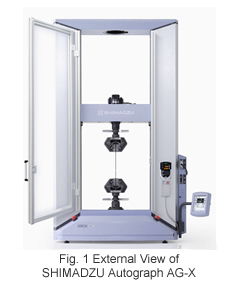Strength Testing of Various Fishing Lines for River Fishing
● Introduction
Various types of technical innovations are continuously appearing which target the hobby and sports fields, and are often the subject of active discussion among enthusiasts. For this Application News, we conducted tensile testing on various fishing lines used in river fishing in mountain streams, and compared their strength and elongation characteristics. Fishing lines in recent years are increasingly composed of advanced metal and polymer materials. They are truly high-tech products with a surprising range of functional variation, and are being introduced to satisfy the wide-ranging needs of enthusiastic anglers.
● Testing Apparatus and Specimens
The apparatus used for this evaluation was the Shimadzu Precision Universal Tester Autograph AG-X Series (typical system is shown in image of Fig. 1), and the test specimens consisted of seven types of sweetfish fishing lines (four types of nylon and one type each of fluorocarbon, composite metal and metallic material from different manufacturers).

● Table 1 Test Specimens for Strength Testing
|
1) Specimen Name |
Fishing Lines |
||||||
|
2) Material |
Nylon |
Fluorocarbon |
Composite metal |
Metal |
|||
|
3) Specimen Number |
Nylon-1 |
Nylon-2 |
Nylon-3 |
Nylon-4 |
Fluorocarbon |
Composite metal |
Metal |
|
4) Thickness Code |
0.175 |
0.175 |
0.175 |
0.175 |
0.175 |
0.05 |
0.02 |
● Test Conditions
The tests for each specimen (7 types of fishing lines) were conducted using the same speed of tensile test load with the conditions shown in Table 2, and the test strength and elongation (stroke) up to specimen breakage were acquired and recorded.
A pneumatic capstan grip (50 N capacity) for wire materials such as string and wires was used for mounting of the specimens, and a 50 N load cell was used for the test strength measurement and control based on the maximum strength of the specimens.
● Table 2 Test Conditions
|
1) Test Apparatus |
: |
Shimadzu Autograph AG-X (50 N load cell) |
|
2) Grips |
: |
50 N pneumatic capstan type yarn grips |
|
3) Test Speed |
: |
200 mm/min |
|
4) Initial Distance Between Grips |
: |
200 mm |
● Test Results
The test results for the 4 types of nylon fishing lines are shown in Fig. 2.
The results indicate that there are no great differences in basic strength and elongation characteristics among materials of the same type. (Strictly speaking, the variation among the 4 types of nylon at the maximum force and maximum elongation (stroke) was about 10%.)

For comparison, the test results for the fluorocarbon, composite metal and metallic specimens are drawn along with Nylon-2, selected as representative of the nylon specimens, as shown in Fig. 3.
According to this, the fluorocarbon has about the same properties as nylon, whereas the metals (metal and composite metal) show extremely small elongation (about one-tenth that of nylon and fluorocarbon), and the composite metal shows extremely large maximum strength (about twice that of the other materials).

The test results (maximum test strength, displacement at break) are summarized for all 7 materials in Table 3, as follows.
● Table 3 Test Results
|
Specimen Number |
Maximum Test Force (N) |
Maximum Displacement (mm) |
|
Nylon-1 |
5.190 |
36.451 |
|
Nylon-2 |
4.727 |
40.304 |
|
Nylon-3 |
5.585 |
41.466 |
|
Nylon-4 |
4.688 |
36.804 |
|
Fluorocarbon |
4.721 |
43.285 |
|
Composite Metal |
9.218 |
6.923 |
|
Metal |
3.827 |
4.721 |
There are differences in functionality even among types of fishing line depending on the intended purpose. However, collecting this sort of quantitation data makes it possible to distinguish among them. The Shimadzu Autograph demonstrates its effectiveness as a material testing apparatus in such cases as that presented here.
|
* |
Please be advised that data obtained before the implementation of the current Weights and Measures Law may be presented in terms of gravimetric unit. |


